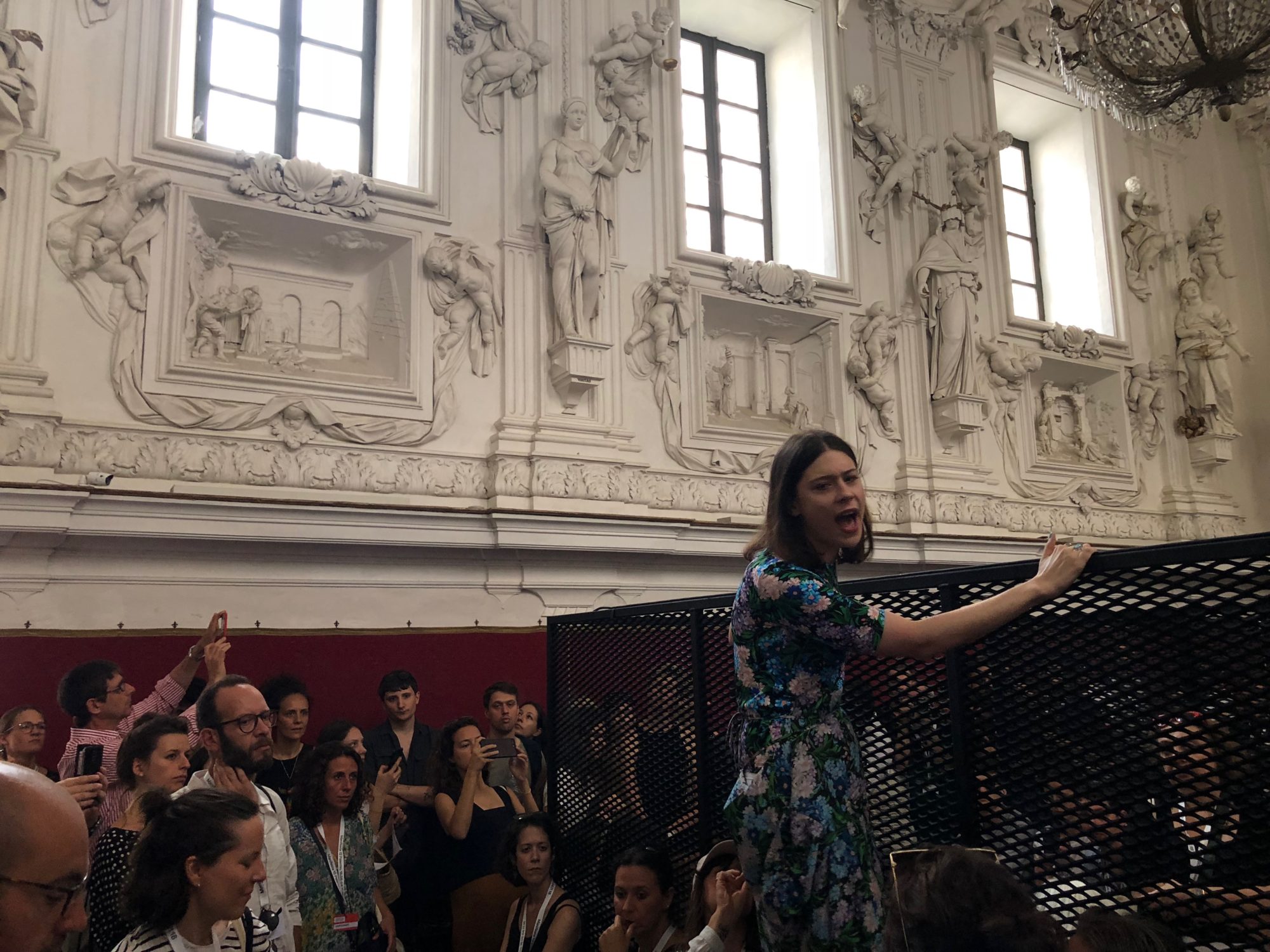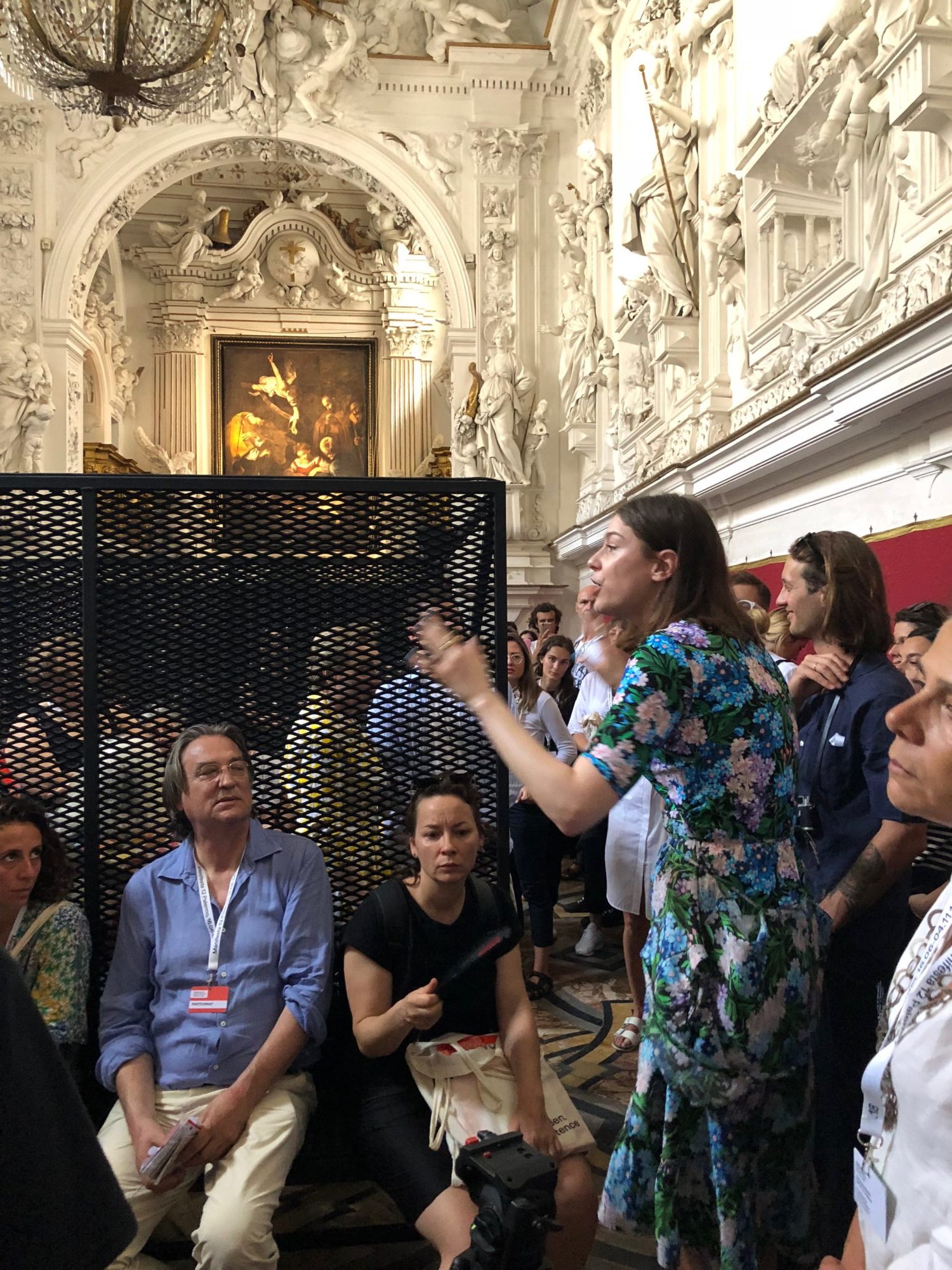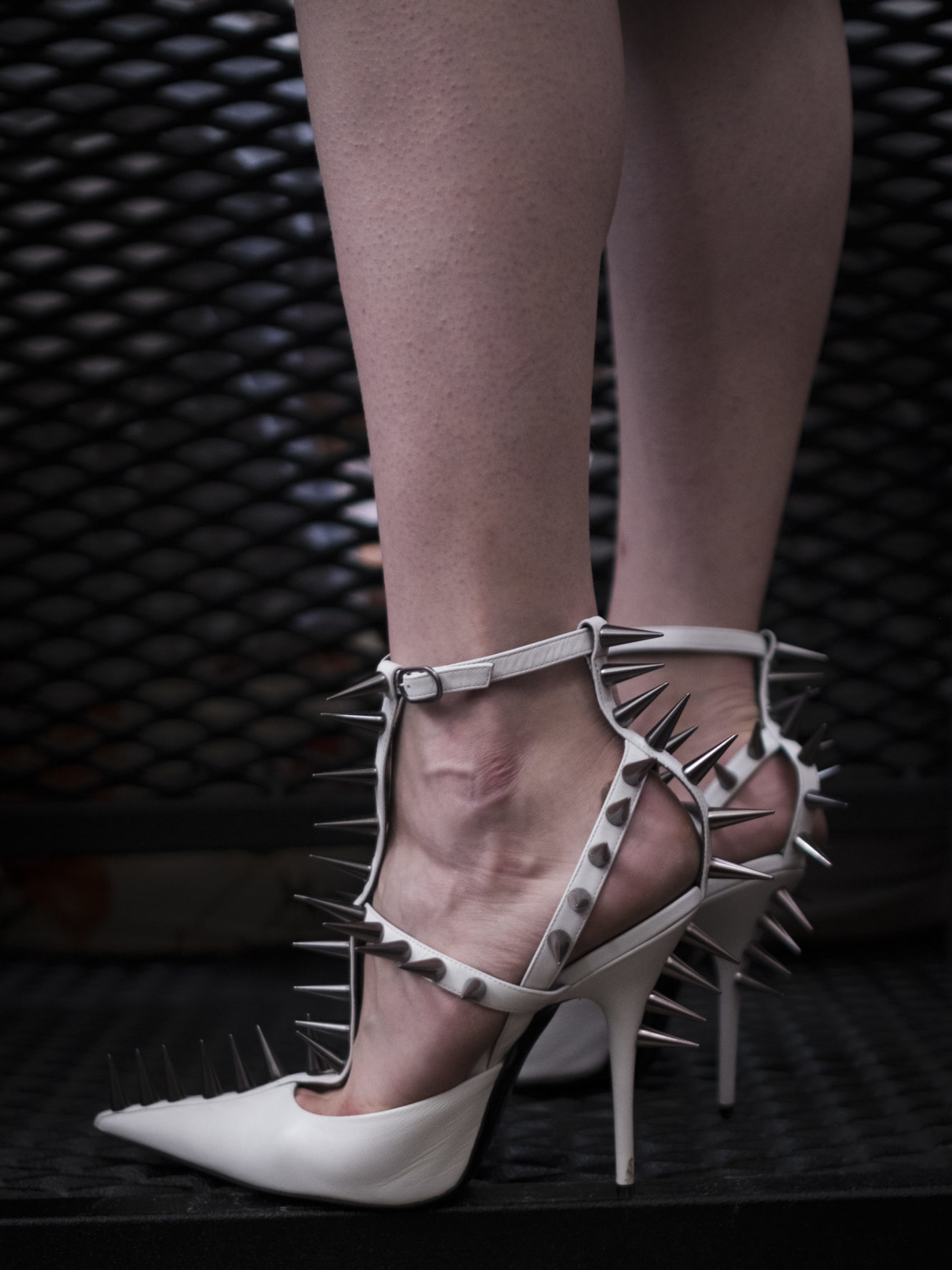Manifesta 12
Nora Turato, “i’m happy to own my implicit biases,” 2018, opening performance, Manifesta Biennale [photo: Wolfgang Träger; courtesy of the Manifesta 12, Palermo]
Share:
Only the early birds of the art world were able to secure a spot in the Oratorio di San Lorenzo to see Manifesta 12 Palermo’s opening performance, i’m happy to own my implicit biases (malo mrkva, malo batina) by Nora Turato. The warm air in the oratorium, which gave up its architectural intimacy in order to host the crowd of VIPs, heated up further around the chattering audience inside. Turato’s nagging voice suddenly breaks in: “You don’t call back—I call again, you don’t call back, I call again,” jolting the waiting audience to attention.
The murmurs of the audience subsided abruptly, and from that moment on Turato proceeded to speak, sing, preach, and shout for about half an hour while moving through the crowd, and climbing along the iron cage that was placed in the middle of the chapel. The script—a composed, rhythmic mixture of platitudes, useless wisdoms, and sharp observations on the contemporary role of women—was secondary to her shimmering presence. Her excessive facial expressions, body gestures, and extravagant movements, combined with her stature—she was by far the tallest person in the room—worked in contrast to the content of her speech. She looked around greedily in search of eyes she could stare into and held eye contact with viewers for as long as 30 seconds. The intensity of her gaze and the perplexity of the text clearly pushed some in the crowd out of their comfort zone. Others even left. She continued, mixing sense with nonsense: “Reading famous quotes about world power does actually increase your world power.” Such brief moments of fragmented legibility came as a relief.
Nora Turato, “i’m happy to own my implicit biases,” 2018, opening performance, Manifesta Biennale [photo: Wolfgang Träger; courtesy of the Manifesta 12, Palermo]
Whereas her floral dress might have been borrowed from an Italian mamma, her six-inch heels were riddled with sharp spikes that could slice anyone who came too close. This grotesque outfit sparked considerations of the contradictory expectations women face in society. Women are expected to balance their way of dressing as much as their modus vivendi: a woman has to be successful but not bitter, strong but not violent, caring but not selfless, sexy and elegant but not vulgar. Turato represents a rowdy housewife who refuses to get in line with the conventional. She also represents the donas de fuera—the women from the outside—who were subjected to persecution in Sicily by the Spanish Inquisition. The manners of these women did not make sense to the Sicilians, who could not understand their behavior.
Turato, an immigrant from Croatia who lives in Amsterdam, is not interested in presenting moralistic facts about our times. Rather, she offers a subjective experience of a familiar feeling: groping in the dark because we cannot make sense of a certain situation. The Croatian idiom malo mrkva, malo batina, which appears in brackets within the title, translates to “the sweet and the whip.” As if taking the expression as a prompt, Turato smiles sweetly at the audience, only to frighten them shortly after by lowering the tone of her voice and crying out “The present is a difficult thing to have taste for!”
The performance introduces some central concerns of the exhibition The Planetary Garden. Cultivating Coexistence, which was developed in cooperation with the Rotterdam-based Office for Metropolitan Architecture (OMA). The Manifesta board ordered the architectural firm to investigate the role of the architecture, archaeology, anthropology, archives, histories and media of Palermo, a former center of the Sicilian Mafia, and address how the city is affected by tourism, gentrification, migration, and climate change. Works produced by more than 40 artists and presented at 16 venues in and around Palermo showed the results of this research: art that is very much politically engaged and that deals with the history and current issues of the city and Europe. The Manifesta team seemed forced toward this curatorial concept to gain a deeper understanding of the geopolitical situation of the host city, perhaps because the Manifesta 11 Zurich curator, German artist Christian Jankowski, came under fire for not learning about the local particularities of Zurich.
Leoluca Orlando, mayor of Palermo, gave impetus to the ethical and political approach of the exhibition. Famous for his fight against the Mafia, which has been marginalized, he now advocates for a culture welcoming to refugees, whom he refers to as Palermitans from the day of their arrival. Whether his credo—that “intolerance” is based in the mind of politicians, not in the stomach of the people—can be proven true remains to be seen. Perhaps the feeling of awkwardness caused by not understanding—as felt in Turato’s performance—drives the cultural conflicts within Palermo, a city that has welcomed many newcomers, mostly from African countries.
Nora Turato, “i’m happy to own my implicit biases,” 2018, opening performance, Manifesta Biennale [photo: Wolfgang Träger; courtesy of the Manifesta 12, Palermo]
The three-channel video installation Unending Lightning (2015–ongoing) from Cristina Lucas, installed in the Casa del Multilato, shows that, in reality, demonizing the Other has often been easier than understanding the Other. The fascist building by Giuseppe Spatrisano, inaugurated in 1939, is a clear example of the Rationalist movement in architecture. Underutilized for more than three decades, it has been reopened to the public for Manifesta 12. Although it is open and filled with sunlight that enters through a giant oculus at its center, the building communicates an assertion of governmental dominance, which was the primary intention of its fascist principals. It is a building that may be attractive to some but ominous for others.
The monumental architecture, however, suits Lucas’ artwork uncommonly well. Each of the three screens of the video installation has a certain function in the work’s visualization of all the aerial bombings that have taken place worldwide since 1911, starting when an Italian lieutenant dropped the first bomb in history on Turkish troops in Libya. The center screen shows a world map that is rather empty, with only a few cities visible. Big letters are inserted from one side of the screen. It’s a word: Rotterdam, accompanied by the dull sound of a collision, gunfire, and an explosion. It is the 10th of May, 1940, and the left screen shows that the bombs come from the German Luftwaffe and states how many civilians were killed. Again, the black letters of Rotterdam fall down onto the map, and a black circle remains as a historical photo of children searching in the ruins appears on the right screen. Again and again, Rotterdam appears on the screen, still on the same day and for the same reason. It is 1945, and Europe is covered in black. Each of these bombings is displayed for only a few seconds, but the film lasts almost seven hours. The documentary photos on the right screen confirm the artist’s excellent research, and, at the same time, they brutalize the viewer’s affective experience. With technical developments the procedures of aerial bombing have become even more automatized and abstract; pressing a button at a distance cannot solve global issues. Instead, the demolition of infrastructures leads to the increase of the refugee flow. Within the European “refugee crisis,” interest is primarily focused on the safety of their borders, while in the global market Europe and its allies do not respect the national borders of others very much, but if their wealth needs to be defended, buttons will be pressed.
This review originally appeared in ART PAPERS “Borders, Barriers,” Fall 2018/2019.
Teresa Retzer studied art history and philosophy in Vienna, Siena and Zurich. Her research focuses upon contemporary art practices and media theory that engage with the influence of digital infrastructures on society. She presented her research at international conferences and wrote scientific texts for catalogues and journals. She wrote art criticism for several art magazines, including “Mousse Magazine,” and “Spike Art Quarterly.” Retzer interprets art writing as possibility to engage with sociopolitical problems, and apart from academic texts on art, she concentrates on right-wing extremist subcultures in former East Germany. Currently she is working on her PhD project, which interrogates new forms of knowledge production in contemporary art and curatorial practices.


